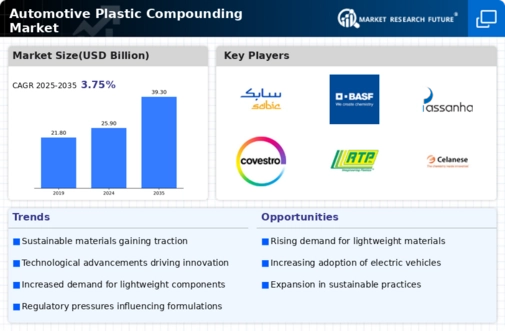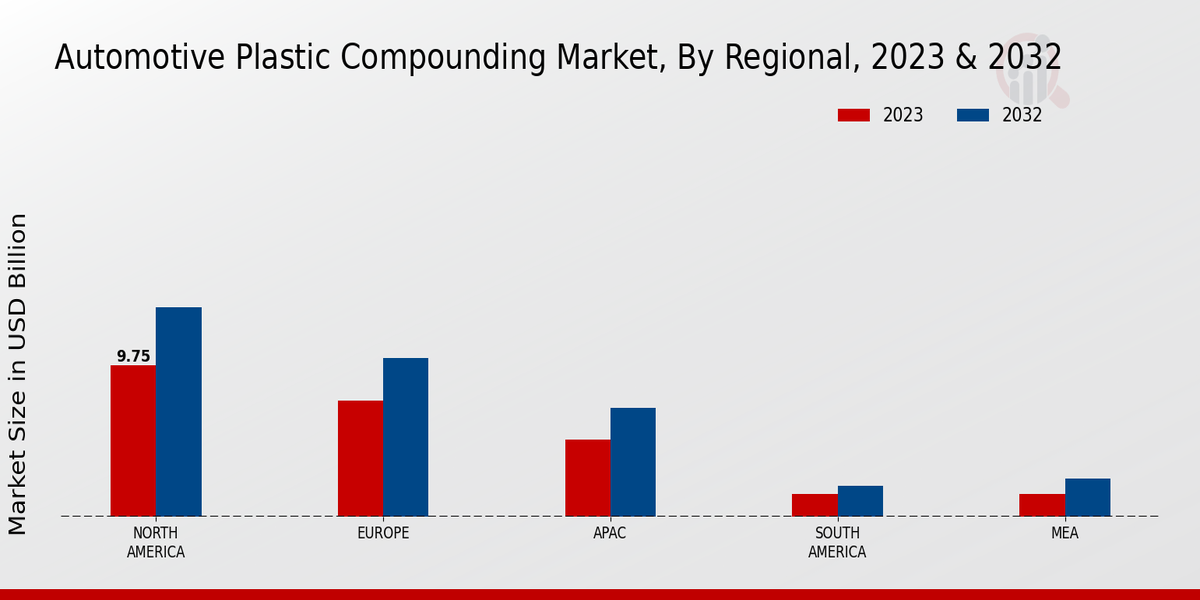Market Growth Projections
The Global Automotive Plastic Compounding Market Industry is projected to experience steady growth over the coming years. With an anticipated market value of 25.9 USD Billion in 2024, the industry is expected to expand at a compound annual growth rate (CAGR) of 3.86% from 2025 to 2035. This growth trajectory reflects the increasing integration of plastics in automotive applications, driven by factors such as lightweighting, sustainability, and technological advancements. By 2035, the market is forecasted to reach 39.3 USD Billion, indicating a robust demand for innovative plastic solutions in the automotive sector.
Increasing Electric Vehicle Production
The rise in electric vehicle production is a pivotal driver for the Global Automotive Plastic Compounding Market Industry. As automakers pivot towards electric mobility, the demand for lightweight and high-performance materials is intensifying. Plastics play a crucial role in the design of electric vehicles, particularly in battery housings and interior components, where weight reduction is vital for enhancing range and efficiency. This shift is expected to propel the market forward, as electric vehicle sales are anticipated to grow significantly in the coming years, further solidifying plastics' position in automotive manufacturing.
Growing Demand for Lightweight Materials
The Global Automotive Plastic Compounding Market Industry is experiencing a surge in demand for lightweight materials, driven by the automotive sector's focus on enhancing fuel efficiency and reducing emissions. Plastics, particularly engineered thermoplastics, are increasingly favored for their lightweight properties compared to traditional materials like metals. This shift is evident as manufacturers seek to comply with stringent environmental regulations and consumer preferences for eco-friendly vehicles. As a result, the market is projected to reach 25.9 USD Billion in 2024, reflecting the industry's commitment to innovation and sustainability in automotive design.
Regulatory Support for Sustainable Materials
Regulatory support for sustainable materials is shaping the landscape of the Global Automotive Plastic Compounding Market Industry. Governments worldwide are implementing stringent regulations aimed at reducing carbon footprints and promoting the use of recyclable materials in automotive production. This regulatory environment encourages manufacturers to adopt advanced plastic compounding techniques that align with sustainability goals. As a result, the market is likely to see an increase in the adoption of bio-based and recycled plastics, which can contribute to a more circular economy within the automotive sector. This trend may also enhance consumer acceptance of vehicles made with sustainable materials.
Rising Consumer Preferences for Customization
Rising consumer preferences for customization are influencing the Global Automotive Plastic Compounding Market Industry. As consumers increasingly seek personalized vehicles, manufacturers are turning to advanced plastic compounding solutions to create unique designs and features. This trend is evident in the growing demand for custom interior components, exterior trims, and specialized functionalities that enhance user experience. The ability to produce tailored solutions using various plastic compounds allows automakers to differentiate their offerings in a competitive market. This shift towards customization is expected to drive growth in the plastic compounding sector, aligning with broader trends in consumer behavior.
Technological Advancements in Compounding Processes
Technological advancements in compounding processes are significantly influencing the Global Automotive Plastic Compounding Market Industry. Innovations such as twin-screw extrusion and advanced mixing techniques enhance the quality and performance of plastic compounds. These developments allow for better material properties, including improved strength, durability, and thermal resistance, which are essential for automotive applications. Furthermore, the integration of automation and smart manufacturing technologies is streamlining production processes, reducing costs, and increasing efficiency. This trend is likely to contribute to the market's growth, with projections indicating a rise to 39.3 USD Billion by 2035.















